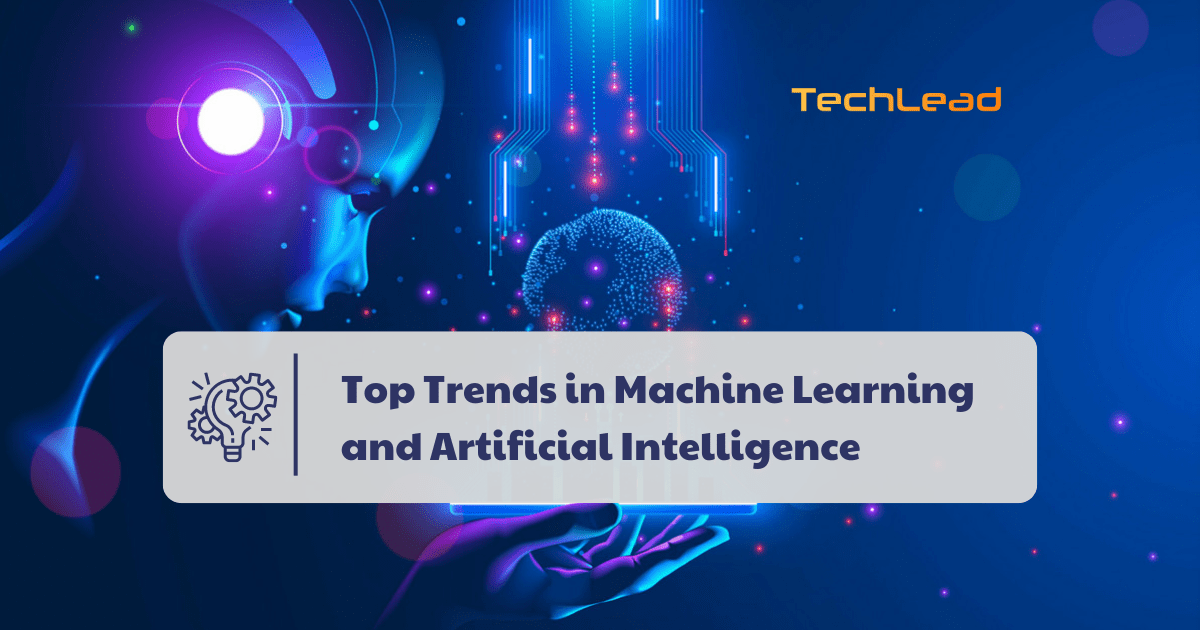Machine Learning involves developing algorithms and models to improve computer systems’ performance on tasks through experience. Contrary to, Artificial Intelligence includes various technologies to simulate human-like intelligence in machines. Join TechLead to explore the top trends in ML and AI!
Prominent trends in machine learning and artificial intelligence

Prominent trends in machine learning and artificial intelligence (Collected)
Leading Trends of Machine Learning
-
Multi-Task Learning
The current trend in machine learning research revolves around the development of models capable of learning from multiple tasks simultaneously. The overarching objective is to enhance the automation and efficiency of machine learning systems, particularly in tackling complex problem domains. By enabling models to assimilate knowledge from diverse tasks, multi-task learning aims to improve generalization performance and alleviate the need for extensive manual feature engineering. Through the joint optimization of multiple objectives, such models can effectively leverage shared representations across tasks, fostering robustness and scalability in learning.
-
Deep Learning and Convolutional Neural Networks
Deep learning continues to dominate the forefront of machine learning innovation, characterized by the proliferation of sophisticated neural architectures such as Transformer, BERT, and GPT (Generative Pre-trained Transformer). Within this landscape, convolutional neural networks (CNNs) stand out as pivotal tools in image and video processing applications. Their hierarchical structure enables efficient feature extraction and abstraction, facilitating tasks such as object detection, facial recognition, and autonomous driving. Through the exploitation of spatial hierarchies, CNNs exhibit remarkable performance in capturing intricate patterns and structures within visual data, thereby underpinning advancements across various domains.
-
Reinforcement Learning
Reinforcement learning has emerged as a prominent paradigm within the machine learning landscape, particularly in domains involving sequential decision-making and autonomous robotics. The advent of algorithms such as Deep Q-Learning and Policy Gradient has propelled the field forward, enabling agents to learn optimal behavior through interaction with their environment. By framing learning as a sequential decision process guided by rewards, reinforcement learning models can adapt to dynamic environments and exhibit sophisticated decision-making capabilities. This versatility has fueled applications ranging from game playing to robotic control, heralding a new era of intelligent autonomous systems.
-
Supervised and Unsupervised Learning
In the realm of supervised learning, methodologies such as Support Vector Machines (SVM), Random Forests, and Neural Networks continue to evolve and refine. These approaches leverage labeled data to infer mapping functions that generalize well to unseen instances, underpinning a wide array of classification and regression tasks. Conversely, unsupervised learning methodologies have garnered significant attention, with techniques like Clustering, Generative Adversarial Networks (GANs), and Self-Supervised Learning gaining prominence. By uncovering inherent structures and patterns within unlabeled data, unsupervised learning techniques facilitate tasks such as data clustering, anomaly detection, and generative modeling, thus complementing the supervised learning paradigm.
-
Question-Answering Systems
Question-answering systems have witnessed a surge in sophistication and versatility, driven by advancements in natural language processing and deep learning. These systems exhibit the ability to comprehend and respond to queries across diverse modalities, including text, images, and audio. Through the integration of techniques such as attention mechanisms and contextual embeddings, question-answering models can discern nuanced semantics and provide contextually relevant responses. This capability finds application in a myriad of domains, from virtual assistants to customer support automation, revolutionizing human-computer interaction paradigms.
-
Adversarial AI
Adversarial AI represents a burgeoning field of research dedicated to studying and mitigating threats posed by malicious and adversarial attacks on machine learning systems. By exploring the vulnerabilities of machine learning models to adversarial manipulation, researchers aim to develop robust defenses and countermeasures against potential exploitation. Techniques such as adversarial training, model distillation, and ensemble learning offer avenues for enhancing the resilience of machine learning systems against adversarial perturbations. Furthermore, the study of adversarial AI underscores the importance of ethical considerations and security protocols in the deployment of machine learning solutions across critical domains.
Notable Trends of Artificial Intelligence
-
Machine Learning and Deep Learning

Machine Learning and Deep Learning (Collected)
Deep Learning has emerged prominently due to its ability to learn from data without human intervention. The utilization of Deep Neural Networks has led to significant advancements in various fields such as natural language processing, computer vision, and data prediction. By leveraging deep neural architectures, complex patterns within data can be effectively captured and utilized for tasks ranging from image recognition to language translation.
-
Reinforcement Learning
Reinforcement Learning is a trend focused on training AI systems to interact with environments and learn from experience. Widely applied in applications like computer gaming, autonomous driving, and asset management, Reinforcement Learning enables agents to make sequential decisions while maximizing cumulative rewards. Through trial and error, these systems can refine their strategies and adapt to dynamic environments, showcasing their potential in complex decision-making scenarios.
-
Explainable AI
The demand for transparency and interpretability in AI models is steadily growing. Explainable AI techniques are being developed to elucidate the decision-making process of AI systems in a logical and understandable manner for humans. By providing insights into the underlying mechanisms of AI models, Explainable AI fosters trust and facilitates collaboration between humans and machines, particularly in critical domains such as healthcare and finance.
-
Integration of AI in the Internet of Things (IoT)
AI integration into IoT devices is driving the creation of intelligent and automated systems. This integration opens up new opportunities for smart applications in domains like smart homes, healthcare monitoring, and industrial automation. By embedding AI capabilities into IoT devices, these systems can autonomously process and analyze data, leading to more efficient and responsive IoT ecosystems.
-
Adversarial AI
Adversarial techniques are being explored to enhance the robustness and security of AI systems. These techniques aim to mitigate the risk of attacks and deception within AI environments. By proactively identifying and defending against adversarial threats, Adversarial AI safeguards AI systems from potential vulnerabilities and ensures their reliability in real-world applications.
-
AI and Society
AI transcends its role as a technological tool, exerting significant influence on society and ethics. It is imperative to regulate and govern the research and application of AI to ensure its societal benefits and mitigate ethical concerns. By aligning AI development with ethical principles and societal values, we can harness its potential to address pressing societal challenges while fostering inclusivity and fairness in its deployment.
Applications of machine learning and artificial intelligence
Machine learning (ML) and artificial intelligence (AI) have emerged as transformative technologies with wide-ranging applications across various sectors. In this discourse, we delve into the myriad applications of ML and AI in diverse fields, ranging from healthcare to finance, highlighting their profound impact on society.
In Healthcare

In Healthcare (Collected)
In the realm of healthcare, ML and AI technologies are revolutionizing diagnosis, treatment, and patient care. Through the analysis of vast amounts of medical data, AI-powered systems can assist healthcare professionals in making more accurate diagnoses, predicting patient outcomes, and personalizing treatment plans. For instance, AI algorithms can analyze medical images such as X-rays and MRI scans to detect abnormalities or assist in early cancer detection. Moreover, AI-enabled wearable devices and health monitoring systems offer continuous health monitoring and early warning systems, empowering individuals to take proactive measures to manage their health.
In Industry and Manufacturing
In the industrial sector, ML and AI play pivotal roles in optimizing manufacturing processes, enhancing efficiency, and reducing operational costs. AI-driven predictive maintenance systems can anticipate equipment failures and schedule maintenance activities, thereby minimizing downtime and improving productivity. Furthermore, AI-powered robotics and automation systems are transforming traditional manufacturing operations, enabling agile and flexible production processes. By leveraging ML algorithms for demand forecasting and supply chain optimization, companies can streamline inventory management and ensure timely delivery of goods, thereby enhancing customer satisfaction and competitiveness.
In Transportation and Logistics

In Transportation and Logistics (Collected)
ML and AI technologies are reshaping the landscape of transportation and logistics, paving the way for smarter, safer, and more efficient systems. Autonomous vehicles, powered by AI algorithms, promise to revolutionize the way people and goods are transported, reducing accidents and congestion while increasing mobility and accessibility. Moreover, AI-driven route optimization and traffic management systems can alleviate congestion, minimize travel time, and reduce fuel consumption, leading to significant environmental and economic benefits. Additionally, AI-enabled predictive maintenance and condition monitoring systems enhance the reliability and safety of transportation infrastructure, ensuring smooth operations and minimizing disruptions.
In Weather Forecasting and Climate
ML and AI techniques are instrumental in improving the accuracy and reliability of weather forecasting models, enabling more precise predictions of weather patterns and extreme events. By analyzing vast amounts of historical weather data and satellite imagery, AI algorithms can identify complex patterns and correlations, leading to more accurate predictions of temperature, precipitation, and severe weather phenomena. Furthermore, AI-powered climate models help scientists understand the intricate dynamics of the Earth’s climate system, facilitating long-term climate projections and informing climate change mitigation and adaptation strategies. Through the integration of AI into weather forecasting and climate modeling, society can better prepare for and mitigate the impacts of natural disasters and climate change.
In Finance and Banking

In Finance and Banking (Collected)
In the realm of finance and banking, ML and AI technologies are driving innovation and transforming traditional business models. AI-powered chatbots and virtual assistants enhance customer service and engagement, providing personalized recommendations and support to clients. Moreover, ML algorithms are employed for credit scoring and risk assessment, enabling more accurate evaluations of borrowers’ creditworthiness and reducing the incidence of default. Additionally, AI-driven algorithmic trading systems analyze market trends and signals in real-time, facilitating informed investment decisions and optimizing portfolio management strategies. Furthermore, AI-based fraud detection systems identify suspicious activities and anomalies in financial transactions, enhancing security and mitigating financial risks.
In Education and Training
ML and AI technologies are revolutionizing the field of education and training, enabling personalized learning experiences and enhancing educational outcomes. AI-powered adaptive learning platforms analyze students’ learning behaviors and preferences, delivering customized learning materials and interventions tailored to individual needs and learning styles. Moreover, AI-driven tutoring systems provide real-time feedback and guidance to students, fostering self-directed learning and mastery of concepts. Additionally, AI-enabled virtual reality (VR) and augmented reality (AR) simulations offer immersive and interactive learning environments, allowing students to explore complex concepts and scenarios in a hands-on manner. Furthermore, AI-driven educational analytics tools analyze student performance data and learning outcomes, enabling educators to identify areas for improvement and optimize instructional strategies.
In conclusion, the applications of ML and AI are vast and multifaceted, spanning across diverse sectors such as healthcare, industry, transportation, weather forecasting, finance, banking, education, and training. These technologies hold immense potential to drive innovation, enhance efficiency, and improve quality of life. As we continue to harness the power of ML and AI, it is imperative to ensure ethical and responsible deployment, mitigate potential risks, and maximize the societal benefits of these transformative technologies.
Challenges and opportunities of machine learning and artificial intelligence
-
Challenges of machine learning and artificial intelligence
In the era of machine learning (ML) and artificial intelligence (AI), one of the most prominent challenges revolves around the quality and completeness of data. The existence of inaccurate, incomplete, or unrepresentative data poses significant hurdles, potentially leading to unreliable outcomes and erroneous decision-making processes.
-
Data Quality and Completeness:

Data Quality and Completeness (Collected)
Data integrity is paramount in the realm of ML and AI. However, the presence of inaccurate or insufficient data can significantly undermine the reliability of predictive models and analytical insights. Whether it’s due to data entry errors, sampling biases, or outdated information, compromised data quality can distort the understanding of real-world phenomena and hinder the effectiveness of AI-driven solutions.
-
Security and Privacy Concerns
The utilization of personal and sensitive data in the training and deployment of ML and AI models raises pertinent questions regarding security and privacy. Organizations must ensure that data is safeguarded and processed in a secure and ethical manner to mitigate the risks of unauthorized access, data breaches, and privacy infringements.
-
Explainability and Transparency
Another challenge lies in the explainability and transparency of ML and AI models. Often perceived as “black boxes,” these models operate without clear visibility into their decision-making processes. This opacity can engender mistrust and reluctance in adopting and utilizing AI applications, particularly in critical domains where accountability and interpretability are paramount.
-
Scalability and Generalization
Achieving scalability and generalization poses technical challenges in the deployment of ML and AI models across diverse environments. A model’s efficacy in one setting does not guarantee its performance in others, necessitating efforts to adapt and optimize models for varying contexts. This requires substantial resources and expertise to ensure robustness and adaptability across different scenarios.
-
Resilience Against Misuse and Abuse
While ML and AI offer promising capabilities in disaster prediction, crime prevention, and societal management, they also carry the risk of misuse and abuse. The same technologies can be repurposed to develop autonomous weapons or facilitate pervasive surveillance, raising ethical and security concerns. Safeguarding against such potential misuse requires stringent regulations and ethical frameworks.
-
Cultural and Societal Challenges
The acceptance and adoption of ML and AI technologies are influenced by cultural, societal, and political factors, leading to disparities in global implementation. Organizations must navigate these complexities to ensure the success and community acceptance of ML and AI projects, addressing cultural sensitivities and social implications in their deployment strategies.
In navigating the landscape of ML and AI, addressing challenges related to data quality, security, transparency, scalability, ethical considerations, and societal acceptance is imperative. By acknowledging and actively mitigating these challenges, stakeholders can foster trust, accountability, and responsible innovation in the development and deployment of AI-driven solutions.
-
Opportunities of machine learning and artificial intelligence
The advent of Machine Learning (ML) and Artificial Intelligence (AI) has revolutionized various aspects of industries and daily life. One of the significant impacts lies in the opportunities they bring, particularly in enhancing efficiency and automation across multiple domains. This essay explores the vast potential of ML and AI in optimizing processes, predicting outcomes, personalizing user experiences, healthcare, autonomous vehicles, finance, supply chain management, robotics, education, and creative content generation.
-
Enhancing Efficiency and Automation

Enhancing Efficiency and Automation (Collected)
ML and AI offer tremendous potential to enhance productivity and streamline workflows through automation. By leveraging algorithms and computational models, these technologies minimize errors, optimize processes, and boost productivity across industries. For instance, in manufacturing, AI-powered systems can automate repetitive tasks, leading to increased efficiency and reduced downtime.
-
Prediction and Data Analysis
ML empowers systems to make predictions based on historical and real-time data, enabling organizations to make informed decisions and forecast future trends accurately. This capability is invaluable in various fields, such as finance, where predictive analytics can aid in risk analysis, automated stock trading, and fraud detection.
-
Improving User Experience
AI can be utilized to create more personalized and superior user experiences. This entails employing ML to recommend products, services, or content tailored to individual preferences and behaviors. By analyzing user data, AI systems can deliver targeted recommendations, enhancing customer satisfaction and engagement.
-
Supply Chain Management
AI can optimize supply chain operations by predicting demand, managing inventory and transportation, and optimizing manufacturing processes. ML algorithms enable proactive decision-making, reducing costs and improving overall efficiency in the supply chain.
-
Creative Content Generation
AI can be harnessed to create novel text, images, music, and videos, unlocking creative possibilities in arts and entertainment. By analyzing existing content and generating new iterations, AI-driven creativity expands the boundaries of artistic expression and content creation.
The opportunities presented by ML and AI are vast and diverse, spanning across industries and sectors. From enhancing efficiency and automation to revolutionizing healthcare, transportation, finance, education, and creative endeavors, these technologies hold immense potential to transform society and drive innovation forward. As we continue to explore and harness the power of ML and AI, the possibilities for growth and advancement are limitless.
Conclusion
In conclusion, the prominent trends in machine learning and artificial intelligence delineate a transformative landscape across various domains. In essence, these trends underscore the dynamic and transformative nature of machine learning and artificial intelligence, heralding a future ripe with innovation and possibilities. As such, it is imperative for individuals to cultivate a deep understanding of these domains and actively engage in their exploration and development. By embracing curiosity, continuous learning, and interdisciplinary collaboration, we can collectively harness the potential of AI to address complex challenges and unlock new frontiers of knowledge and discovery. Thus, let us embark on this journey with enthusiasm and determination, for the future of AI holds promise and opportunity for those willing to explore and innovate.





